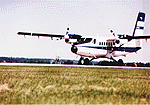AFM-2 BOREAS Operations in 1994
Objectives:
The NRC Twin Otter (FT) was flown to measure the fluxes of energy and trace gases on site-specific tracks near the primary flux towers, as well as on a 16x16-km grid, and regional transects during all three growing season IFC's of BOREAS. The data will be used to develop various techniques to obtain large area flux estimates of mass and energy using aircraft, tower and remotely sensed data. Measurements made along the transect between the SSA and the NSA will be used to characterize the spatial variations of canopy conductance and determine its usefulness for inferring mass and energy exchange of radiatively important trace gases (CO2, O3, etc.).
Types of Data/Equipment Used:
The NRC Twin Otter atmospheric research aircraft was instrumented to make accurate measurements of the three orthogonal components of atmospheric motion, as well as supporting meteorological parameters such as temperature and dew point, and radiometric data, including incident and reflected solar radiation, surface temperature, greenness index (IR/R), and a four channel satellite simulator. Trace gas analyzers included the Agriculture Canada infrared absorption C02/H20 analyzer, a LICOR-6262 C02/H20 analyzer, three ozone analyzers (2 fast-response, and a TECO-49 for means). All data were recorded at a rate of 16-Hz. BORIS contains run-average meteorological, radiometric and flux data, a run being typically 10-16 km in length. Interested scientists can acquire 16-Hz data from the NRC directly for specific studies.
Flight Summary:
The flight summary that follows includes the operational area (SSA, NSA or transect between), and a brief summary of the tracks flown. Grid flights consist of 9 parallel 16-km tracks at a spacing of 2 km, each grid flown twice for a total of 18 lines. 'Ag' refers to a 18-km agricultural track just NE of Prince Albert. Site specific runs were flown past the principal flux towers identified by: OBS (Old Black Spruce), OJP (old Jack Pine), OA (old Aspen), YJP (Young Jack Pine) and the Fen (SSA only); these runs were usually done in sets of several repeated reciprocal runs; the number in brackets after each entry is the number of runs flown. Another track was flown in the NSA over the 1979 burn in the south half of the grid area. 'CL' refers to the Candle Lake run, a 115-km transect in the SSA across a variety of surface cover from aspen, to mixed forest, a burn, and old black spruce, as well as three lakes (Halkett, Candle, and White Gull). 'L' indicates the L-pattern flown from way points h-i-j identified in the BOREAS Operations Plan, and 'R' denote a special overflight of the NOAA radar set up near OJP in the NSA. 'S' indicates that a sounding, or atmospheric profile was flown, generally from near the surface to above the top of the mixed layer. 'INT' means an intercomparison was accomplished between the Twin Otter and one of the other flux aircraft (KA for King Air, LE for Long-EZ)
 This summary refers to just those flights archived in BORIS; it excludes transit and test flights. The Twin Otter flew a total of 57 project flights in the growing season phase of BOREAS. Including transit and test flights, 116 flights totaled 257 flying hours.
This summary refers to just those flights archived in BORIS; it excludes transit and test flights. The Twin Otter flew a total of 57 project flights in the growing season phase of BOREAS. Including transit and test flights, 116 flights totaled 257 flying hours.
Instrumentation Status:
A flight-by-flight listing of instrumentation problems and status is given in BORIS. Only the main points are listed here.
- Satellite simulator in Landsat MSS mode, 15-deg field of view, for Flights 01-27 and 49-57; in SPOT mode, 15-deg field of view, for Flights 28-48
- Wind data all corrected for INS drift using Kalman filtering technique
- The LOZ-3 ozone analyzer removed from aircraft after Flight 22: Archived fluxes are from the German DLR fast-response analyzer for all flights.
- The Agriculture Canada fast-response C02 analyzer appears to have over-estimated C02 fluxes, due to a noise problem correlated with vertical gust at wavelengths of around 100m. Although H20 signal appeared to be unaffected, the LICOR C02 and H20 data have been used in the BORIS submission.
AFM Overview || AFM-1 | AFM-2 | AFM-3 | AFM-4 | AFM-5 | AFM-6
AFM-7 | AFM-8 | AFM-9 | AFM-11 | AFM-12 | AFM-13 | AFM-14 | AFM-15
 Send a data request to the BOREAS Data Manager (BOREAS Investigators only)
Send a data request to the BOREAS Data Manager (BOREAS Investigators only)
E-Mail a comment on this page to the curator 
Send e-mail to Keith Kaminsky, the BORIS representative for the AFM group 
Return to the AFM Overview
Return to the BOREAS Science Groups Overview
Return to the BOREAS Home Page
Last Updated: October 20, 1997
 The BOREAS Information System
The BOREAS Information System
 The NRC Twin Otter
The NRC Twin Otter